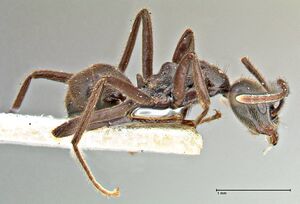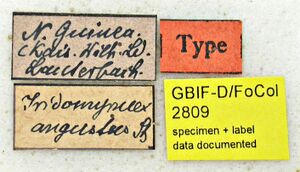Anonychomyrma angusta
| Anonychomyrma angusta | |
|---|---|

| |
| Scientific classification | |
| Kingdom: | Animalia |
| Phylum: | Arthropoda |
| Class: | Insecta |
| Order: | Hymenoptera |
| Family: | Formicidae |
| Subfamily: | Dolichoderinae |
| Tribe: | Leptomyrmecini |
| Genus: | Anonychomyrma |
| Species: | A. angusta |
| Binomial name | |
| Anonychomyrma angusta (Stitz, 1911) | |
Identification
Distribution
Distribution based on Regional Taxon Lists
Indo-Australian Region: New Guinea (type locality).
Distribution based on AntMaps
Distribution based on AntWeb specimens
Check data from AntWeb
Countries Occupied
| Number of countries occupied by this species based on AntWiki Regional Taxon Lists. In general, fewer countries occupied indicates a narrower range, while more countries indicates a more widespread species. |

|
Estimated Abundance
| Relative abundance based on number of AntMaps records per species (this species within the purple bar). Fewer records (to the left) indicates a less abundant/encountered species while more records (to the right) indicates more abundant/encountered species. |

|
Biology
Anonychomyrma species are common in moist to semi-arid forested areas (and are less common in rain forests). They nest either in soil with or without coverings, or arboreally in living or dead wood. Workers forage in conspicuous trails on the ground and on tree trunks. Although not studied in detail, they seem to be general predators and also collect plant juices. Some species are associated with the caterpillars of selected butterflies. Nest sizes are moderate to large, ranging from 500 to tens of thousands of workers. When disturbed, most species elevate their gasters and release strong, acrid smelling chemicals as a defensive measure. While similar to Iridomyrmex in general habitat preferences and ecology, most Anonychomyrma prefer moister sites and are predominately arboreal. Iridomyrmex species occur in drier sites and are predominantly terrestrial.
Castes
Worker
     
| |
| . | |
Nomenclature
The following information is derived from Barry Bolton's Online Catalogue of the Ants of the World.
- angusta. Iridomyrmex angustus Stitz, 1911a: 369, fig. 15 (w.) NEW GUINEA (Papua New Guinea).
- Type-material: syntype workers (number not stated; “a few”).
- Type-locality: Papua New Guinea (“Kaiser-Wilhelmsland”): (no further data) (Lauterbach).
- Type-depository: MNHU.
- Combination in Anonychomyrma: Shattuck, 1992a: 13.
- Status as species: Chapman & Capco, 1951: 188; Shattuck, 1994: 4; Bolton, 1995b: 66.
- Distribution: Papua New Guinea.
Description
References
- Shattuck, S. O. 1992a. Review of the dolichoderine ant genus Iridomyrmex Mayr with descriptions of three new genera (Hymenoptera: Formicidae). J. Aust. Entomol. Soc. 31: 13-18 (page 13, combination in Anonychomyrma)
- Stitz, H. 1911a. Australische Ameisen. (Neu-Guinea und Salomons-Inseln, Festland, Neu-Seeland). Sitzungsber. Ges. Naturforsch. Freunde Berl. 1911: 351-381 (page 369, figs. 15 worker described)
References based on Global Ant Biodiversity Informatics
- Emery C. 1913. Hymenoptera. Fam. Formicidae. Subfam. Dolichoderinae. Genera Insectorum 137: 1-50.
- Janda M., G. D. Alpert, M. L. Borowiec, E. P. Economo, P. Klimes, E. Sarnat, and S. O. Shattuck. 2011. Cheklist of ants described and recorded from New Guinea and associated islands. Available on http://www.newguineants.org/. Accessed on 24th Feb. 2011.
- Shattuck S. O. 1994. Taxonomic catalog of the ant subfamilies Aneuretinae and Dolichoderinae (Hymenoptera: Formicidae). University of California Publications in Entomology 112: i-xix, 1-241.
- Stitz H. 1911. Australische Ameisen. (Neu-Guinea und Salomons-Inseln, Festland, Neu-Seeland). Sitzungsberichte der Gesellschaft Naturforschender Freunde zu Berlin 1911: 351-381.

